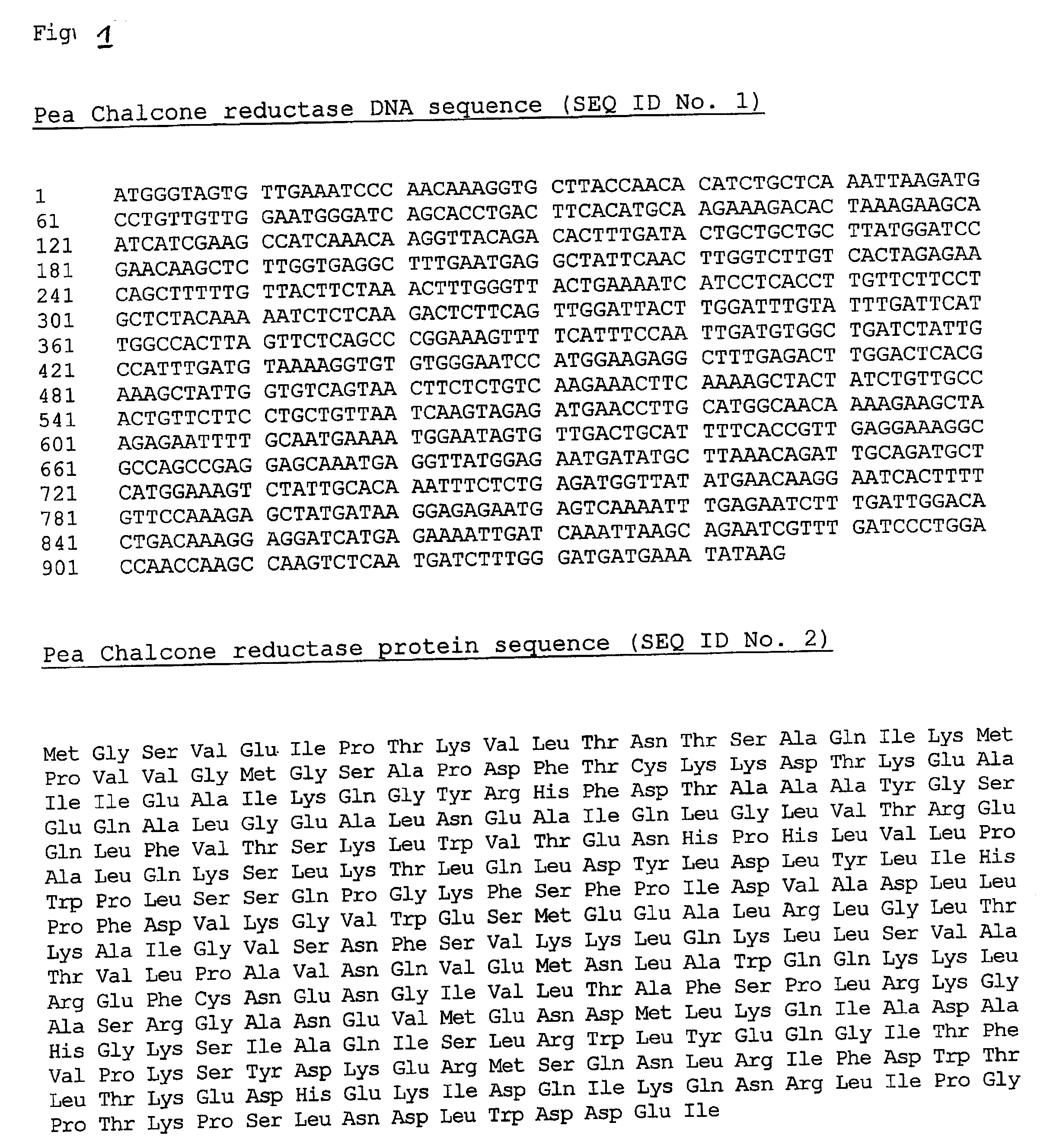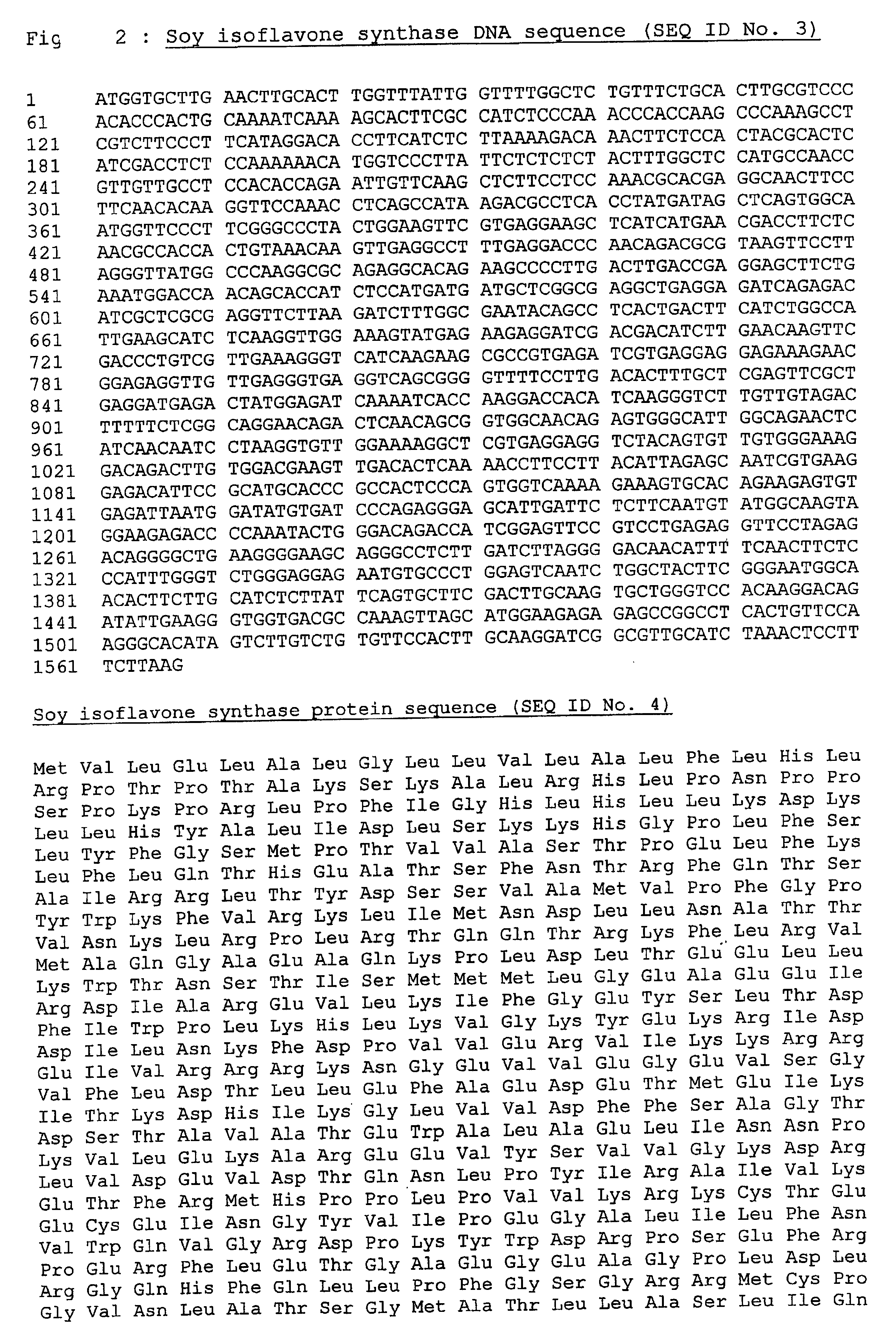Nutritionally enhanced plants
a technology of plant nutrients and plants, applied in the field of plant nutrition content improvement, can solve the problems of not allowing the formation of daidzein in many respects, adversely affecting the flavour profile, etc., and achieve the effects of improving the activity of chi, increasing chr, and improving the ar
- Summary
- Abstract
- Description
- Claims
- Application Information
AI Technical Summary
Benefits of technology
Problems solved by technology
Method used
Image
Examples
example 1
cDNA Cloning of Chalcone Reductase, Chalcone Isomerase and Isflavone Synthase and the Generation and Analysis of Transgenic N. tabacum
1.1 Plant Material
[0108] All experiments can be performed using normally available tobacco (Nicotiana tabacum) genotypes as the starting material. N. tabacum cultivar SR1 is such a genotype. Plants of N. tabacum cultivar SR1 were grown in controlled temperature growth rooms with a 16-hour photoperiod at a temperature of 25° C.
1.2 Bacterial Strains
[0109]Escherichia coli strain XL1-Blue: recA1, endA1, gyrA96, thi-1, hsdR17, supE44, relA1 lac [F′proAB laClqZΔM15 Tn10 (Tetr)] (Stratagene Europe, The Netherlands). Transformation of E. coli XL1-Blue was performed using the method of Hanahan (1983). Agrobacterium tumefaciens LBA4404 (Hoekema, 1985). Transformation of Agrobacterium tumefaciens LBA4404 was performed according to Shen and Forde (1989).
1.3.1 Total RNA Isolation
[0110] RNA was isolated from Lotus corniculatus (Lotus), Gl...
example 2
Transformation of Lettuce
Stable Transformation of Lactuca Sativa L. cv Lollo Rossa, Bijou, Muscara & Revolution
[0168]A. tumefaciens cells from PCR positive colonies were used to inoculate a 10 ml Lennox media broth containing kanamycin 50 μg / ml and rifampicin 50 μg / ml and incubated overnight with shaking (120 rpm) at 29° C. The overnight culture was centrifuged at 3000 g and the cell pellet resuspended in an equal volume of UM media and a 1:10 (v / v) dilution used for transformation.
[0169] Cotyledons were cut from 7-day old Lactuca Sativa L. seedlings grown in tissue culture. The abaxial surface of the cotyledons was scored with a scalpel-blade before placing directly into the A. tumefaciens suspension and co-incubated for 10 minutes.
[0170] The cotyledons were then transferred, abaxial surface down, to solidified UM media supplemented with 3% (w / v) sucrose overlayed with one filter paper (8 per plate) and placed at 25° C. for 2 days. The cotyledons were then transferred, axial su...
example 3
Transformation of Potato
Stable Transformation of Solanum tuberosum L. cv. Desiree
[0174]A. tumefaciens cells from transgene positive (PCR) colonies were used to inoculate a 20 ml Lennox media broth containing kanamycin 50 μg / ml and rifampicin 50 μg / ml and incubated for 3-days with shaking (120 rpm) at 29° C. Following incubation, this culture was centrifuged at 3000 g and the cell pellet resuspended in 25 ml MS media (pH5.8) supplemented with 3% (w / v) sucrose.
[0175] Leaves were cut from 4-week old Solanum tuberosum L. plants, grown in tissue culture, and placed axial surface up onto solidified L3 medium [MS basal salts supplemented with 1.6% glucose, 0.8% agar, pH5.8] supplemented with 0.02 mg / l NAA, 20 mg / l GA3, 2 mg / l Zeatin riboside] and placed at 23° C. for 2 days.
[0176] The excised leaves were then placed directly into the A. tumefaciens suspension and co-incubated for 10 minutes. Following co-incubation, the leaves were ‘blotted-dry’ and transferred, axial surface up, to f...
PUM
| Property | Measurement | Unit |
|---|---|---|
| temperature | aaaaa | aaaaa |
| particle size | aaaaa | aaaaa |
| particle size | aaaaa | aaaaa |
Abstract
Description
Claims
Application Information
 Login to View More
Login to View More - R&D
- Intellectual Property
- Life Sciences
- Materials
- Tech Scout
- Unparalleled Data Quality
- Higher Quality Content
- 60% Fewer Hallucinations
Browse by: Latest US Patents, China's latest patents, Technical Efficacy Thesaurus, Application Domain, Technology Topic, Popular Technical Reports.
© 2025 PatSnap. All rights reserved.Legal|Privacy policy|Modern Slavery Act Transparency Statement|Sitemap|About US| Contact US: help@patsnap.com



